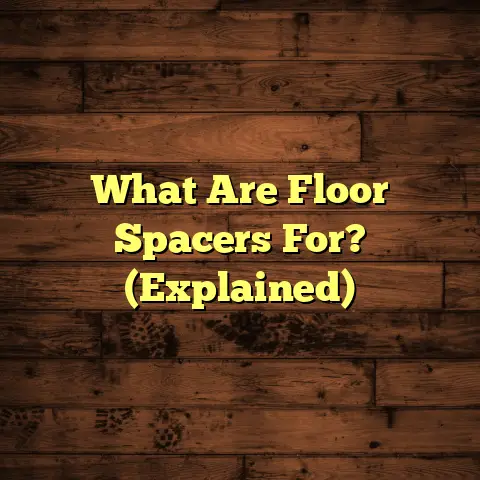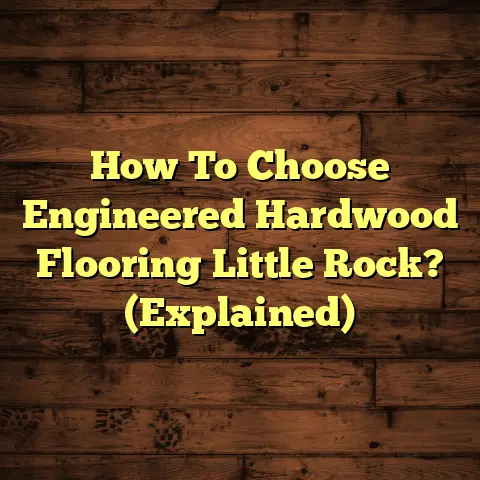Can You Install Lvp Floor Over Laminate Flooring? (Explained)
Thinking about upgrading your floors but dreading the mess of tearing out old laminate?
You’re not alone.
Many homeowners wonder if they can skip the demolition and install luxury vinyl plank (LVP) flooring directly over existing laminate.
It seems like a time-saver—but is it a smart move?
In this post, we’ll break down whether it’s possible, what factors to consider, and the pros and cons of laying LVP over laminate.
If you’re aiming for a smooth, long-lasting finish, this guide will help you decide the right path forward.
Understanding Flooring Types
What is LVP?
Luxury Vinyl Plank (LVP) is a popular flooring choice that closely resembles hardwood or stone.
It is made from multiple layers, including a wear layer, design layer, and backing layer.
LVP is known for its durability, water resistance, and ease of maintenance.
The top layer is designed to withstand scratches and stains, making it ideal for high-traffic areas in the home.
In my experience, LVP has transformed spaces in my home.
I initially chose it for my kitchen and dining area due to its water resistance, which was crucial given the occasional spills.
The planks I selected were a distressed oak style, which added warmth and character to my otherwise modern design.
What is Laminate?
Laminate flooring consists of a core layer made from high-density fiberboard (HDF) and a photographic layer that imitates wood or stone.
While laminate can be more affordable than hardwood or LVP, it’s less durable and can be susceptible to moisture damage.
In my previous home, I opted for laminate in the living room because of its affordability—around $1.50 to $3 per square foot at the time.
The Case for Installing LVP Over Laminate
Benefits of Installing LVP Over Laminate
- Cost Savings: One of the most significant advantages I found was the cost-effectiveness of not having to remove the existing laminate.
Hiring professionals for removal can add up quickly, often ranging from $1 to $3 per square foot. - Time Efficiency: The time saved by skipping the removal process was invaluable.
I completed my installation in a weekend rather than several days, which was essential as I was eager to enjoy my new floors. - Less Waste: By leaving the laminate in place, I contributed less to landfill waste—a small win for sustainability.
Potential Drawbacks
- Height Considerations: As I mentioned earlier, adding LVP over laminate increases the overall height of the flooring.
This can lead to issues with door clearances or transitions to other rooms.
In my case, I had to adjust a couple of doors to ensure they would swing without hitting the new flooring. - Moisture Concerns: If the existing laminate has been exposed to water damage, this could lead to mold or mildew issues underneath the new flooring.
Before installation, I thoroughly inspected the laminate for any signs of damage and was relieved to find none.
Preparing for the Installation
Assessing Your Existing Flooring
Before diving into installation, I recommend conducting a thorough assessment of your current laminate flooring:
- Check for Damage: Look for warping, buckling, or severe scratches.
I found one small area of damage that I fixed with a leveling compound. - Test for Levelness: Use a level tool across various areas of your floor.
Any dips or high spots need addressing for a successful LVP installation.
Gathering Materials and Tools
Here’s a list of materials and tools I gathered before starting my project:
- Luxury Vinyl Plank Flooring: I chose a high-quality product with a 20-mil wear layer for durability.
- Underlayment: Even though LVP often comes with built-in underlayment, I opted for an additional layer for sound reduction—especially important in my multi-level home.
- Utility Knife: Essential for cutting planks to size.
- Straight Edge: To ensure clean cuts.
- Measuring Tape: Accurate measurements are crucial.
- Tapping Block: Helps with fitting planks together without damaging edges.
- Pull Bar: Useful for snugging planks together at the edges.
- Broom and Vacuum: For cleaning the existing laminate before installation.
Installation Process
Step-by-Step Guide
- Preparation: After gathering my materials, I began by cleaning the existing laminate thoroughly.
A vacuum followed by a damp mop ensured there was no dust or debris left behind. - Acclimation: I placed the unopened boxes of LVP in the room where they would be installed for 48 hours, allowing them to acclimate to room temperature and humidity levels.
- Installing Underlayment: If using additional underlayment, I rolled it out across the laminate flooring, ensuring it was flat and without wrinkles.
- Laying the First Row: I started in one corner of the room and laid the first plank with the tongue side facing the wall.
As I went along, I used spacers to maintain an expansion gap around the edges. - Continuing Installation: Each plank clicked into place easily.
I staggered the joints by cutting some planks in half and alternating their placement—this gave a more natural look. - Cutting Planks: For areas needing cuts—like around door frames—I measured carefully and used my utility knife for precise cuts.
- Finishing Touches: Once all planks were installed, I removed spacers and added trim around the edges to cover the expansion gap.
Successes and Challenges
Reflecting on my installation experience:
Successes
- The click-lock system made installation straightforward; I managed without any help.
- The transformation of my living space was immediate and impressive; the new LVP added a fresh, modern touch that complemented my furniture beautifully.
Challenges
- Ensuring the entire surface was level took more time than anticipated.
Using leveling compound was necessary in a few spots but added extra labor. - Managing transitions between rooms became a point of concern; I needed to install transition strips carefully to ensure they looked seamless.
Maintenance and Care for LVP
One of the standout benefits of LVP is its low maintenance requirements:
- Regular Cleaning: I recommend weekly sweeping or vacuuming to keep dirt and debris from scratching the surface.
- Mopping: Occasionally, I use a damp mop with a gentle cleaner specifically designed for vinyl flooring.
Avoiding harsh chemicals is key to preserving its finish. - Preventative Measures: Using mats at entry points helps reduce dirt tracked onto the floor, which is something I’ve found beneficial in maintaining its appearance.
Cost Analysis
To give you an idea of costs involved in my project:
- LVP Flooring Cost: Approximately $4 per square foot for 350 square feet = $1,400
- Underlayment Cost: About $0.50 per square foot = $175
- Installation Supplies (tools etc.): Around $100
Total costs came to about $1,675—considerably less than full removal and installation would have cost me!
Comparing Options
When considering flooring options, it’s essential to weigh different types available against your needs:
LVP vs. Laminate
- Durability: LVP generally outperforms laminate regarding water resistance—ideal for kitchens and bathrooms.
- Aesthetic Appeal: Both can mimic wood but LVP often has more realistic textures and finishes due to advanced manufacturing processes.
- Comfort Underfoot: LVP tends to feel softer underfoot compared to laminate, which can be important if you spend long hours standing.
LVP vs. Hardwood
While hardwood offers timeless beauty and value:
- Cost: Hardwood can range from $5 to $12 per square foot plus installation costs.
- Maintenance: Hardwood requires regular refinishing and is susceptible to water damage—something I wanted to avoid entirely.
Advanced Considerations
As someone who has put considerable thought into flooring choices, here are some advanced considerations you might want to think about:
Environmental Impact
When choosing flooring materials, consider their environmental footprint:
- Many LVP products are made from recycled materials.
- Look for options that offer low VOC emissions if air quality is a concern.
Long-Term Value
While LVP is durable, consider how it fits into your long-term plans:
- If you plan on selling your home soon, high-quality LVP can be attractive to buyers who want modern aesthetics without maintenance hassles.
- However, if you intend to stay long-term and prefer natural materials, investing in hardwood may make more sense.
Practical Tips Based on My Experience
Here are some practical tips I’ve learned through my journey with flooring:
- Take Your Time During Measurement: Measure twice; cut once!
Accurate measurements prevent unnecessary mistakes that can cost time and money. - Don’t Rush Acclimation: Allowing your LVP to acclimate properly helps avoid future issues with expansion or contraction once installed.
- Choose Quality Products: Investing slightly more in high-quality LVP can pay off in terms of durability and appearance over time.
- Consider Professional Help for Large Areas: If you’re tackling a large space or multiple rooms, consider hiring professionals for speed and efficiency—particularly if time is a concern.
Conclusion
In conclusion, installing luxury vinyl plank over laminate flooring is not only feasible but can also be an efficient way to upgrade your space without incurring excessive costs or labor time.
My experience has shown me that with careful preparation and attention to detail, stunning results are achievable.
Whether you’re looking at this option due to budget constraints or simply want a quick upgrade, consider your specific situation and weigh the pros and cons thoughtfully.
With proper planning and execution, you too can enjoy a beautiful new floor that enhances your home’s aesthetic appeal while providing practicality for years to come!





